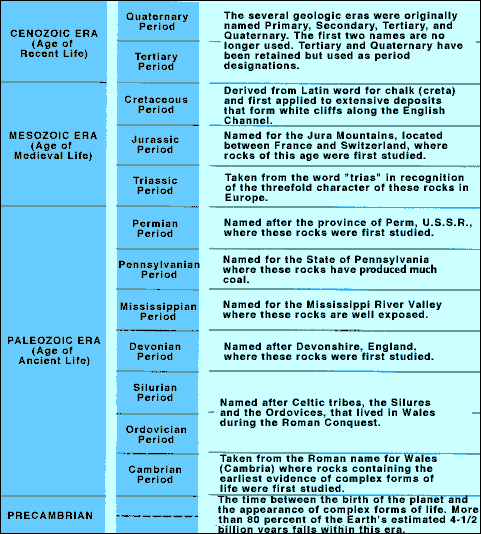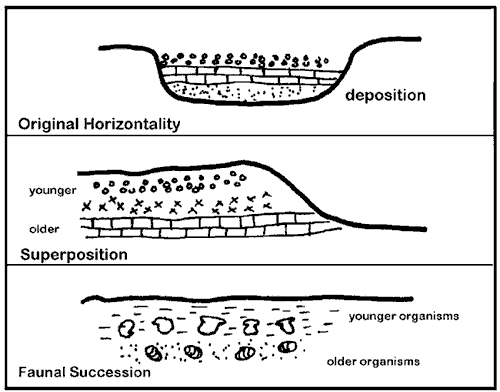BACKGROUND:
Students are familiar with dinosaurs and other fossils,
but the idea that certain organisms lived at certain times is very difficult
for them to comprehend. The oldest unmistakable fossils are about 3.8
billion years old. However, multicellular organisms did not appear in the
fossil record until approximately 650 million years ago. Animals with hard
body parts (skeletons) did not appear until about 580 million years ago.
Geologic time is often very difficult to understand. Most
students have trouble understanding the impact of 10 years, not to mention
the 4.5 billion years that have passed since the formation of the Earth. It
is difficult to date exactly how old the Earth is because no one was there
to record the event. There are many lines of evidence for the age of the
Earth, within your students' lifetimes this number will probably change
slightly as new technology helps us to better date the past.
An accurate sense of geologic time and Earth history was
very difficult for scientists to construct. It was not until the mid 1700's
that James Hutton, who developed some of the modern principles of
stratigraphy, realized that the history of the Earth was of unimaginable
length of time, and that the "present was the key to the past."
Hutton tried to develop methods that used present rates of sediment
deposition to interpolate how much time had passed since the deposition of a
particular rock layer.
Organisms have evolved over the course of
the Earth’s evolution. Since paleontologists have recorded and study these
changes, geologists can use the type of fossils in a rock to tell estimate
its age relative to other rocks. For example, the dinosaurs lived and became
extinct long before human ancestors evolved. Therefore, a rock containing
dinosaur fossils would be much older than one containing hominid remains.
This type of geologic time telling is called relative geologic time; it
gives the order of events, fossils, and rocks from oldest to youngest,
without reference to numerical ages.

Relative time is based on several principles of
stratigraphy (the arrangement of sedimentary rock layers. These are the
principles of Original Horizontality, Superposition, and Faunal
Succession. The principle of Original Horizontality, first proposed by
William Smith in the late 1700's, states that sedimentary layers formed in a
horizontal position. If mountain building took place and the layers were
tilted or moved, this event must have occurred after the layers were laid
down.
The Principle of Superposition states that in a
sequence of sedimentary rock layers, the bottom layers are older than the
top layers. The bottom layers were deposited first. The principle of Faunal
Succession is similar to Superposition; it states that the oldest fossils in
a series sedimentary rock layers will be in the lowest layer. Progressively
younger fossils occur in higher layers.
So time is determined by fossils
that are in different layers (strata). If you look at the
horizontal component, you are looking at one time period and understand
the paleoenvironment. In this activity students are asked to look at
a dinosaur gravesite and try to identify the type od dinosaur.
PROCEDURE:
- llustrate geologic time using the analogy of a 24 hour clock
representing the 4.5 billion years of earth history. Draw the clock
(shown below) on your blackboard. The creation of the major types of
animals was not until 20:00, and humans were not around until 30 seconds
before 24:00! Humans have only been on this Earth for a very short
period. Dinosaurs were on this planet for much longer than we have been

- Emphasize that the history of geologic time was very difficult for
scientists to construct. Explain how relative time is based on
stratigraphic principles. You may wish to use the diagram below to help
illustrate these principles.

- The activity looks at a dinsosaur gravesite and have students
looking at what bones can be identified. The dinosaur is a
Stegosaurus.